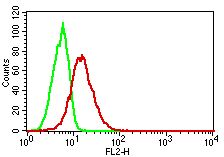Monoclonal Antibody to Human/ Mouse TLR2 (Clone : T2.5)(Discontinued)

Figure-1:Flow analysis of human/mouse TLR2 antibody (Clone:T2.5): Cell surface staining of Raw cells, blue represents TLR2, red represents Isotope control mouse IgG1. 2 µg antibody was used for staining. Goat Anti-mouse PE was used as secondary antibody.
Roll over image to zoom in
Shipping Info:
For estimated delivery dates, please contact us at [email protected]
| Format : | Purified |
| Amount : | 500 µg |
| Isotype : | Mouse IgG1 |
| Content : | 0.5 mg, 0.2 µm filtered antibody solution in PBS containing 0.1% BSA |
| Storage condition : | Product should be stored at 4 °C. Under recommended storage conditions, product is stable for one year. |
The monoclonal antibody 10-3506 recognizes human Toll-like receptor 2 (TLR2). Toll-like receptors (TLR) are highly conserved throughout evolution and have been implicated in the innate defense to many pathogens. At present, ligands for several of the TLR's, such as TLR2-6,9, have been identified, confirming their role in first line defense against invading microorganism. In mammals, TLRs are identified as type I transmembrane signaling receptors with an extracellular portion containing leucine-rich repeats with pattern recognition capabilities. Pathogen recognition by TLRs provokes rapid activation of innate immunity by inducing proliferation of proinflammatory cytokines and upregulation of costimulatory molecules and eventually toinitiation of adaptive immunity. TLR2 has been identified as a receptor that is central to the innate immune response to lipoproteins of Gram-negative bacteria, several whole Gram-positive bacteria, as well as a receptor for peptidoglycan and lipoteichoic acid and other bacterial cell membrane products. It is suggested that TLR2 is able to recognize such a wide variety of PAMPs (pathogen-specific molecular patterns) by forming heterodimers with other TLRs like e.g. TLR6. TLR2 is essential for recognizing lipopeptides and lipoproteins from several microorganisms and also peptidoglycans derived from gram-positive bacteria. Bacterial species as diverse as mycobacteria, spirochetes, mycoplasma, Staphylococcus aureus, and Streptococcus pneumoniae have all been shown to mediate cellular activation via TLR2.
IHC-F: 6 µm sections were fixed with aceton. Sections were blocked with goat serum and exposed o/n with T2.5.
FC: 4x10^4 leukocytes/ml were stained for 30 minutes at 4 °C.
Functional assay: mice were injected i.p. with 1 mg T2.5, after 1h incubation mice were challenged;T2.5 5 µg/ml was added to cell culture.
IP: 40 µg cleared protein was incubated with 2 µg T2.5 for 1h at 4 °C. IA: T2.5 as a detector.
For Research Use Only. Not for use in diagnostic/therapeutics procedures.
1: Yarandi SS, Kulkarni S, Saha M, Sylvia KE, Sears CL, Pasricha PJ. Intestinal Bacteria Maintain Adult Enteric Nervous System and Nitrergic Neurons via Toll-like Receptor 2-induced Neurogenesis in Mice. Gastroenterology. 2020 Mar 29. pii: S0016-5085(20)30404-2. doi: 10.1053/j.gastro.2020.03.050. [Epub ahead of print] PubMed PMID: 32234538.
| Subcellular location: | Cell membrane, Cytoplasmic vesicle, Membrane raft |
| Post transnational modification: | Glycosylation of Asn-442 is critical for secretion of the N-terminal ectodomain of TLR2. |
| Tissue Specificity: | Detected in a macrophage cell line, smooth muscle, lung, spleen, thymus, brain and adipose tissue. Cell surface expression detected in lung alveolar macrophages, dendritic macrophages and at lower levels in lung macrophages (at protein level) (PubMed:19362712). |
|
There are currently no product reviews
|


















.png)










